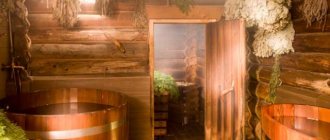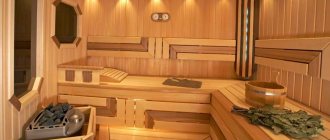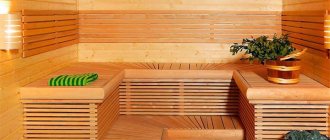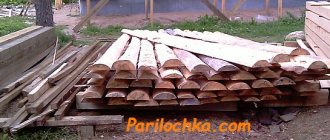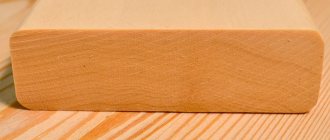Let's assume that the owner of the bathhouse has already made a choice in favor of hardwood for the interior lining of the bathhouse.
And then he is faced with the need to place a bet on one of the two most frequently offered materials with similar properties. You have to choose: lining for a bathhouse - aspen or linden? Is it possible to say which type of wood is best for a bathhouse? Well, the difference between them is really not too big . Nevertheless, we will try to define it more clearly, compare the real characteristics of one and the other breed, and the final decision, of course, is for the reader.
Why is it important to pay special attention to the material for finishing the bath?
Decorating a bathhouse is a matter of not only aesthetics, but also comfort during water procedures.
In this case, wood is considered one of the best options, since it is environmentally friendly, pleasant to the touch, beautiful, and inexpensive. However, not every tree can be used for rooms with strong changes in temperature and humidity. For example, conifers release resin abundantly when heated, which means they are not suitable for finishing steam rooms. Another important note: under the influence of unfavorable conditions, wood gradually collapses. This suggests that it is necessary to choose the most durable, impact-resistant rock.
Aspen and linden have long been used in Russian baths. Their popularity can be explained by:
- long experience of use as finishing materials;
- low cost;
- ease of processing.
Thus, the choice of these types of wood for a bath can be called successful. However, in order for these finishing materials to last as long as possible, it is necessary to use them taking into account information about their properties.
Larch bathhouse
When choosing a material for a bathhouse, you need to take into account not only the heat capacity of wood, but also other characteristics. Unlike a residential building, the wood here is exposed to intense exposure to steam, water and temperature fluctuations, because the building is heated only during bathing. Not every material can withstand such a load.
An excellent option for a bathhouse is larch. The tree is a coniferous tree, meaning it contains a fairly large amount of resin. High resin content ensures amazing resistance of larch to rot, fungi, and water.
If the products are made of pine, it is necessary to varnish and protect them from moisture. Larch does not need this. On the contrary, over time it only becomes stronger than oak.
The advantages of wood are not limited to unique resistance to decay. Accordingly, a larch bathhouse will have the following features:
- strength - the density of larch is only slightly less than that of oak, a structure made from this tree will last a long time, as it is not subject to mechanical damage;
- resistance to rain, snow and heat ensures the longevity of the bath;
- larch lining includes a small number of knots, and this means not only aesthetics, but also greater strength of the boards and logs themselves;
- the wood has a beautiful texture and is very attractive;
- a log bathhouse made of larch does not require any protective measures; there is no need for periodic treatment with antiseptics, insect repellents, or stains;
- lining made from this material has the same advantages as logs.
There are also disadvantages to a bathhouse made of larch:
- it is at least 2 times more expensive than pine;
- wood is processed with some difficulty, so the bathhouse itself will also cost more.
Comment! Larch floors are still used in European castles. Its age reaches 300–400 years.
Features of aspen, its advantages and disadvantages
One of the advantages of aspen is its light color, which successfully complements the interior of almost any bathhouse or sauna. In addition, the tree of this species has antiseptic properties and practically does not rot. Other characteristics of aspen include:
- durability;
- the ability to withstand repeated long-term changes in temperature and humidity without compromising strength;
- almost complete absence of resin.
However, it should be borne in mind that over time the wood of this species will darken slightly. In addition, it does not absorb protective compounds well.
Video description
Video material will help you choose the mounting option for the lining
Installation of sheathing
The installation of the lathing allows not only to secure the lining, but also to insulate the bathhouse. This primed block structure is also designed to allow air circulation under the finish. Thanks to the movement of air masses, the inside of the finishing material will dry quickly. The free space will still allow condensation to drain freely. Therefore, the likelihood of mold, rot, and fungus will decrease.
Important! Galvanized profiles cannot be used under finishing lamellas.
In addition, the sheathing under the lining in a bathhouse in a steam room or in another room allows for electrical wiring. It is necessary both for lighting and for installing sockets.
Installation of steam room sheathing Source sibdok.ru
Internal insulation under the lining
At the beginning of work, waterproofing is fixed to the walls. It is nailed or pressed against the sheathing bars. Mineral wool slabs are mainly used as a heat insulator. The insulating material is installed in the empty sections of the sheathing.
Advice! It is recommended to cut the cotton wool into pieces with 10 mm overlaps on each side. In this case, the heat insulator can be placed tightly into the sheathing.
Next, the thermal insulation material together with the frame is covered with a vapor barrier. At this stage, foil material is used as it is able to reflect heat. The vapor barrier is laid with an overlap. Specialists must glue the joints with aluminum tape.
Narrow slats with a maximum thickness of 20 mm are fixed on top of the vapor barrier. Thanks to their use, a ventilation gap is created between the foil and the finishing lumber.
Characteristics and properties of linden, its differences from aspen
Linden board is a popular finishing material due to its large selection in stores and affordable price. However, this type of wood also has other successful characteristics:
- softness;
- nice smell;
- low thermal conductivity.
It differs from aspen in a warmer, richer shade. In addition, linden contains many beneficial essential oils. However, it is more often affected by pests and is more susceptible to rotting and destruction. Unfortunately, linden also darkens, and even faster than aspen.
Not wood covering
If you don’t like wood and prefer other finishing materials, tiles, fiber cement and plastic are at your service. It is no secret that this material is cheaper, and some are even safe.
Plastic panels are only suitable in the rest room and locker room - this material cannot be used at high temperatures. Ceramic tiles and fiber cement have proven themselves better - they are durable and reliable materials.
Fiber cement boards and plastic panels
Fiber cement board for finishing a washing room in a bathhouse is a suitable material, which is a mixture of sand, cement and cellulose.
Density depends on the amount of air and water added. Medium-density slabs are intended for finishing houses and baths - the material does not break and has been serving for a long time for more than a hundred years.
Thanks to the presence of cement, the slabs are waterproof and heat-saving. The presence of minerals adds plasticity. Let's look at the main advantages of fiber cement boards.
- Completely environmentally friendly material without harmful substances;
- Good moisture resistance - there are bubbles inside the slabs that push water out;
- Fire resistance - the material is not subject to fire and can contain a fire;
- Strength and longevity - the service life of fiber cement boards is from 30 to 60 years. The material proved to be better than wood and plastic;
- Easy installation and reasonable price.
As for plastic panels as a material for finishing a bathhouse, the situation here is the opposite: like any brainchild of the oil industry, plastic finishing is completely unsuitable for bathhouses and other similar places. The material is prone to ignition and is filled with toxic substances.
The only suitable place for plastic panels is the locker room, that is, the least hot place where a person spends the least amount of time. Plastic, even at low temperatures, releases toxic elements into the atmosphere, which is felt in the form of an unpleasant odor. However, from a cost point of view, this is the cheapest option for finishing the premises.
Comparison of linden and aspen
When choosing what is best for a bathhouse, you should first answer the question of what kind of finishing is planned. When using each type of wood, it is advisable to take into account important nuances.
For a log bathhouse
The wood for the exterior decoration of a log bathhouse, just like the material from which the building is made, must be durable, resistant to extreme heat and precipitation. In this case, both linden and aspen may be suitable, but the following recommendations must be taken into account:
- when choosing linden, a more careful selection of material is necessary;
- it is also not recommended to be used for cladding the lower part of the structure due to a lower degree of protection from moisture;
- aspen can be used with virtually no restrictions.
Before use for exterior finishing, antiseptic treatment of wood is required, and when choosing linden boards, it is better to do it most carefully.
For finishing the steam room
When finishing work in the hottest bath room, the heat resistance and durability of the material come to the fore. It is not surprising that many experts recommend aspen. Several arguments can be given in favor of choosing this type of wood.
- When exposed to high temperatures, aspen does not release resin at all and does not overheat. This means that there will be no risk of getting burned.
- Even after many years of use in a steam room, it does not swell or collapse, but, on the contrary, gains strength: over time it can be compared with oak in this characteristic.
Perhaps the only drawback when choosing aspen will be a barely perceptible bitter odor when this type of wood is heated. However, after a while he will leave.
For finishing the dressing room and rest room
The temperature and humidity in the dressing room and relaxation room are much lower than in the steam room, which means that significantly fewer requirements are placed on the choice of material.
We can say that it is permissible to use the tree of the species that you like most or that fits better into the allocated budget. At the same time, it is still worth listening to the recommendations of experts. Here are some of them:
- Linden can be used with almost no restrictions to decorate a rest room. Its essential oils, which are released into the air when heated, will improve the microclimate in the room.
- When decorating a shower room, it is preferable to choose aspen, since it tolerates high humidity much better.
Both types of wood in question are excellent for bath furniture. However, linden can be called more popular because it is softer in structure and therefore easier to process.
Regardless of whether linden or aspen for a bathhouse becomes your final choice, remember the importance of applying antiseptic compounds to the material. They will protect the tree from negative influences, which means they will extend its service life by several decades (the treatment should be repeated regularly). In addition, it is advisable to pay attention to the absence of serious defects in the wood before purchasing it.
Classic lining, eurolining, calm.
Classic lining
Regular or classic lining is distinguished by thin narrow strips; the chamfers of classic lining are straight.
Eurolining
This type of material has heavier and wider boards, which are of great interest in the design of different rooms and have exactly the same characteristics as thin material. The chamfers are rounded, the tenon is shorter and thicker.
Calm
This lining is even thicker, stronger and more expensive, the tenon is longer than that of the Euro lining, but the chamfers are rounded.
Due to the fact that there are cuts on the back side of the boards, the lining lasts longer and does not warp over time - the cuts relieve stress in the board that occurs during drying
Important! When purchasing lining for a steam room, please note that there should be no knots. It is the knots that heat up the fastest and can cause burns. In addition, they may fall out!
